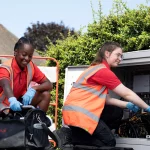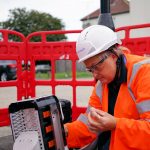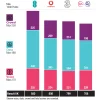EE UK to Boost 4G Speeds by Refarming 10MHz of 1800MHz Spectrum from 2G
Mobile operator EE (BT) has today announced that they intend to further boost the top speeds and reliability of their “superfast” 4G based mobile data network by converting (“refarming“) another 10MHz of radio spectrum in the 1800MHz band from older 2G services.
At present EE’s fastest 4G (LTE) based mobile sites are equipped with 20MHz of the 1800MHz spectrum band, as well as 35MHz of the 2.6GHz band (note: some of the 1800MHz band is also be used for older 3G and 2G services). However these days fewer devices require 2G connectivity and so the operator is shifting more of the spectrum in order to help 4G based Mobile Broadband performance.
As a result of that, more than 600 sites across cities including London, Birmingham, Manchester, Edinburgh and Cardiff, will be upgraded with the latest 4G spectrum over the next 6 months. The sites will power the next wave of mobile devices to hit the UK market, equipped with “Cat 12” and “Cat 16” modems.
Advertisement
The operator already claims to have the “largest 4G+ footprint for both Cat 6 and Cat 9 modems.” In theory the best Cat 6 devices (i.e. most 4G Smartphones built over the past few years) should be able to deliver Mobile Broadband speeds of up to 300Mbps, while Cat 9 (e.g. Samsung Galaxy S6 onwards) will do up to 450Mbps. By comparison Cat 16 reflects the very latest devices and pushes close to Gigabit territory (here).
Marc Allera, EE CEO, said:
“We keep investing in our network, and using our technology leadership to make sure customers are getting the most out of the latest smartphones. Customers need to be on 4G, getting the best out of their new devices with the highest quality phone calls and the fastest mobile data speeds. We’re converting 2G into 4G, because that’s what our customers need. So if you are choosing a new smartphone, the message is simple: there’s only one UK network that offers the best smartphone experience.”
The operator claims that it’s 4G network now covers 85% of the United Kingdom’s landmass (c.99% population coverage) and the upgrade should mean that those with the latest Smartphones benefit by “doubling the data upload speeds” from the current maximum of 50Mbps and up to 100Mbps via more than 900 sites across the United Kingdom.
In reality such capacity needs to be shared between many users and the signal quality does vary, which means that most people will probably experience considerably slower performance than the theoretical claims. However some people may be using the service at just the right time and in just the right location to benefit from ultrafast style performance.
It’s worth remembering that different parts of EE’s network are at different stages of development and performance isn’t all about spectrum. The operator has also introduced other upgrades, such as 4×4 MIMO and 256QAM (Quadrature Amplitude Modulation) technology, both of which can help to improve speeds.
Advertisement
Mark is a professional technology writer, IT consultant and computer engineer from Dorset (England), he also founded ISPreview in 1999 and enjoys analysing the latest telecoms and broadband developments. Find me on X (Twitter), Mastodon, Facebook, BlueSky, Threads.net and Linkedin.


















































Comments are closed